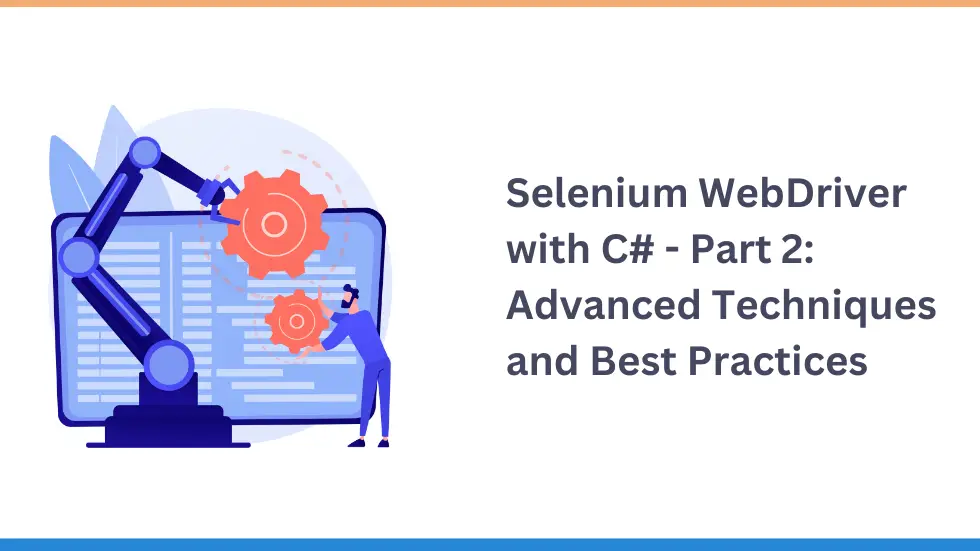In today’s competitive digital landscape, ensuring software reliability through test automation is essential. This blog explores Advanced Selenium WebDriver techniques with C#, focusing on robust synchronization strategies, design patterns, configuration management, and scalability through parallel execution.
Whether you’re an enterprise with complex systems or a startup looking to automate fast, mastering advanced Selenium WebDriver techniques will help you build a high-performing test automation framework that’s maintainable, scalable, and production-ready.
1. Advanced Wait Strategies in Selenium WebDriver
Flaky tests are a common issue in UI automation. The key to stability lies in mastering Selenium wait strategies beyond just implicit waits.
Explicit Waits with WebDriverWait
Explicit waits allow you to target dynamic elements more precisely:
csharp
CopyEdit
WebDriverWait wait = new WebDriverWait(driver, TimeSpan.FromSeconds(10));
wait.Until(ExpectedConditions.ElementToBeClickable(By.Id(“submit-btn”)));
Other conditions include waiting for:
- Text presence
- Title matches
- URL fragments
- Element visibility or invisibility
Custom Wait Conditions
For even more control, define custom wait conditions tailored to your application’s UI:
csharp
CopyEdit
public static Func<IWebDriver, bool> ElementHasClass(By locator, string className) {
return driver => driver.FindElement(locator).GetAttribute(“class”).Contains(className);
}
Custom waits are a hallmark of advanced Selenium WebDriver with C# techniques and are critical for enterprise-level reliability.
2. Advanced User Interactions
Handling complex UI actions can elevate your Selenium framework from basic to enterprise-grade.
Using the Actions Class
Simulate user behavior like drag-and-drop, hover, or key combinations:
csharp
CopyEdit
Actions actions = new Actions(driver);
actions.MoveToElement(menu).Click().SendKeys(“search”).SendKeys(Keys.Enter).Perform();
Executing JavaScript
Some UI elements resist standard WebDriver actions. JavaScript execution solves this:
csharp
CopyEdit
js.ExecuteScript(“arguments[0].click();”, element);
js.ExecuteScript(“arguments[0].scrollIntoView(true);”, element);
These approaches make your framework more adaptable and robust.
3. Building Maintainable Tests with Page Object Model (POM)
A strong test automation framework relies on structure. The Page Object Model in Selenium provides that structure.
Base Page Class
Create a reusable base class for element interactions:
csharp
CopyEdit
public abstract class BasePage {
protected IWebDriver driver;
protected WebDriverWait wait;
// Click, input, get text, etc.
}
Page-Specific Classes
Encapsulate logic for individual pages:
csharp
CopyEdit
public class LoginPage : BasePage {
public LoginPage EnterCredentials(string email, string password) { … }
public DashboardPage ClickLogin() { … }
}
This separation improves code clarity, maintainability, and test reusability.
4. Configuration Management for Enterprise Flexibility
Avoid hardcoded values. Centralize configs for browser choice, timeouts, and headless options:
csharp
CopyEdit
public static string BaseUrl => ConfigurationManager.AppSettings[“BaseUrl”];
public static bool RunHeadless => bool.Parse(ConfigurationManager.AppSettings[“RunHeadless”]);
Pair this with a WebDriver factory pattern to manage cross-browser compatibility.
5. Robust Error Handling and Logging
Test failures are inevitable—but debugging shouldn’t be painful.
Capture Screenshots on Failure
csharp
CopyEdit
if (TestContext.CurrentContext.Result.Outcome.Status == TestStatus.Failed) {
var screenshot = ((ITakesScreenshot)driver).GetScreenshot();
screenshot.SaveAsFile(“Screenshots/failure.png”);
}
Graceful Cleanup
Ensure WebDriver instances are properly disposed after each test.
6. Scaling with Parallel Execution
Running your tests in sequence slows you down. Leverage parallel test execution in Selenium:
csharp
CopyEdit
[assembly: Parallelizable(ParallelScope.Fixtures)]
Isolate your tests, avoid shared states, and watch your CI pipelines speed up significantly.
7. Handling Complex UI Elements with Selenium
Modern apps include dynamic elements like alerts, modals, iframes, and tabs.
Example Scenarios:
- Alerts: driver.SwitchTo().Alert().Accept();
- Tabs: Use WindowHandles to switch contexts
- Iframes: driver.SwitchTo().Frame(“frameName”);
Handling these well is a key part of mastering advanced Selenium WebDriver techniques.
8. File Upload Automation
Uploading files via Selenium? Just send the path directly to the file input element:
csharp
CopyEdit
fileInput.SendKeys(filePath);
You can even wait for upload indicators to disappear using ExpectedConditions.InvisibilityOfElementLocated.
9. Best Practices Checklist
| Category | Best Practice |
| Framework Design | Use Page Object Model and factory patterns |
| Wait Strategy | Use explicit and custom waits |
| Test Design | Write isolated, descriptive, data-driven tests |
| Error Handling | Take screenshots and manage cleanup |
| Performance | Run tests in parallel; optimize locators |
| Maintainability | Centralize configuration and use base classes |
Conclusion
Implementing these advanced Selenium WebDriver best practices will elevate your automation framework from functional to world-class.
With proper wait strategies, design patterns like POM, configuration handling, and support for complex UI elements, your framework will be ready for enterprise-scale testing.
At EmbarkingOnVoyage Digital Solutions, we help enterprises and startups implement robust, scalable automation solutions using C# and Selenium WebDriver.
Our solutions are tailored for real-world applications with CI/CD integration and test coverage that scales with your business.
Additional Resources:
